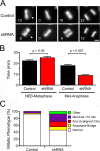Mps1 kinase activity restrains anaphase during an unperturbed mitosis and targets Mad2 to kinetochores
- PMID: 18541701
- PMCID: PMC2426934
- DOI: 10.1083/jcb.200712028
Mps1 kinase activity restrains anaphase during an unperturbed mitosis and targets Mad2 to kinetochores
Abstract
Mps1 is an upstream component of the spindle assembly checkpoint, which, in human cells, is required for checkpoint activation in response to spindle damage but not apparently during an unperturbed mitosis. Mps1 also recruits Mad1 and Mad2 to kinetochores. However, whether the enzymatic activity of Mps1 is required for these processes is unclear. To address this question, we established an RNA interference (RNAi) complementation assay. Repression of Mps1 triggers premature anaphase, often with unaligned or maloriented chromosomes. This phenotype is rescued by an RNAi-resistant wild-type Mps1 transgene but not by a catalytically inactive mutant. An analogue-sensitive allele, Mps1(M602A), also rescues the RNAi-induced defect, but not when inhibited by the adenosine triphosphate analogue 1-NM-PP1. Thus, Mps1 activity does restrain anaphase during an unperturbed mitosis. Furthermore, although catalytically inactive Mps1 can restore kinetochore localization of Mad1, only the active kinase restores Mad2 localization. Thus, in human cells, Mps1 catalytic activity is required for spindle checkpoint function and recruitment of Mad2.
Figures




References
-
- Abrieu, A., L. Magnaghi-Jaulin, J.A. Kahana, M. Peter, A. Castro, S. Vigneron, T. Lorca, D.W. Cleveland, and J.C. Labbe. 2001. Mps1 is a kinetochore-associated kinase essential for the vertebrate mitotic checkpoint. Cell. 106:83–93. - PubMed
-
- Baumann, C., R. Korner, K. Hofmann, and E.A. Nigg. 2007. PICH, a centromere-associated SNF2 family ATPase, is regulated by Plk1 and required for the spindle checkpoint. Cell. 128:101–114. - PubMed
-
- Campbell, M.S., G.K. Chan, and T.J. Yen. 2001. Mitotic checkpoint proteins HsMAD1 and HsMAD2 are associated with nuclear pore complexes in interphase. J. Cell Sci. 114:953–963. - PubMed
-
- Clute, P., and J. Pines. 1999. Temporal and spatial control of cyclin B1 destruction in metaphase. Nat. Cell Biol. 1:82–87. - PubMed
-
- Dorer, R.K., S. Zhong, J.A. Tallarico, W.H. Wong, T.J. Mitchison, and A.W. Murray. 2005. A small-molecule inhibitor of Mps1 blocks the spindle-checkpoint response to a lack of tension on mitotic chromosomes. Curr. Biol. 15:1070–1076. - PubMed
Publication types
MeSH terms
Substances
Grants and funding
LinkOut - more resources
Full Text Sources
Other Literature Sources
Research Materials

